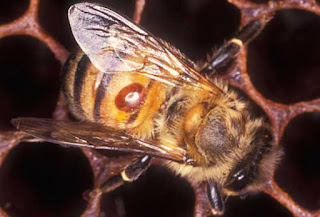 |
| A honey bee visits and apple blossom. It may someday be protecting that flower from a bacterial infection |
(This post originally appeared on Forbes on 2/1/16)
Bees and other pollinator insects are critical for the production of 15-30% of the crops on which we depend. Honey bees also supply us with delicious honey. There is yet another service that we may soon be getting through the agency of this hard-working category of insects. There is a start-up company in Ontario, Canada called BVT (Bee Vectoring Technology), which is enlisting bees in the control of crop pests. This idea has been explored for some time, but BVT is hammering out the practical and regulatory steps needed to make it a commercial reality working with both honeybees and bumble bees. I’ll explain the logic behind this approach below.
| Apple trees damaged by fire blight, a bacterial disease that enters through flowers (photo PlantDoctor) |
Because bees selectively and efficiently visit the flowers on a crop, they are ideal candidates to deliver biological agents or chemicals to manage several important plant diseases whose infective strategy involves flowers. One example would be Fire blight of apples and pears, caused by a bacterium that only infects through flowers (Erwinia amylovora). An antibiotic or biological control agent delivered by bees would be an elegant solution. There is also a group fungal pathogens which colonize the petals and other portions of the flowers after they decline (various species of Botrytis, Sclerotinia and Monilinia).These fungi use the energy-base of the dead flower parts in order to grow their way into the green, growing portions of the plant. They cause serious diseases of sunflowers, Canola, almonds, strawberries, and stone fruits. Once again, bees can be a targeted agent to get fungicides or biocontrol agents in place on the flowers to then deny that foothold to the pathogens.
 |
| Brown rot of stone fruits may eventually destroy the fruit, but the infection of flowers is a key stage of the disease (Photo APS) |
When bee-delivered, control can be more effective than general, foliar sprays because they can arrive at each flower as it opens, something that happens over a period of time. Bee-delivered products use ~95% less material because they are not being applied to anything in the orchard or field other than the flowers. Obviously the pest control agents have to be safe for the bees themselves and pass all the other regulatory screens for human and environmental safety, but there are many promising options that can meet those hurdles. There may even be agents that the bees can move back into their hives to control some of their own pests.
 |
| Note the red Varroa mite on this honey bee. That serious parasite also spread virus diseases of bees |
BVT’s work is based on 20 years of research initiated at the University of Guelph by entomologist John Sutton, plant pathologist Peter Kevan and agronomist Todd Mason. They have developed a tray of powder placed at the hive door so that the bees pick up some material to spread to flowers. Field trials conducted with Les Shipp of Agriculture Canada have been very encouraging and BVT, is working with bee specialists like Sydney Cameron of the University of Illinois to insure bee safety. The CEO, Michael Collinson, is confident that BVT will be able to make a major contribution to Integrated Pest Management systems and to do so in a way which is good for both farmers and bees.





Comments